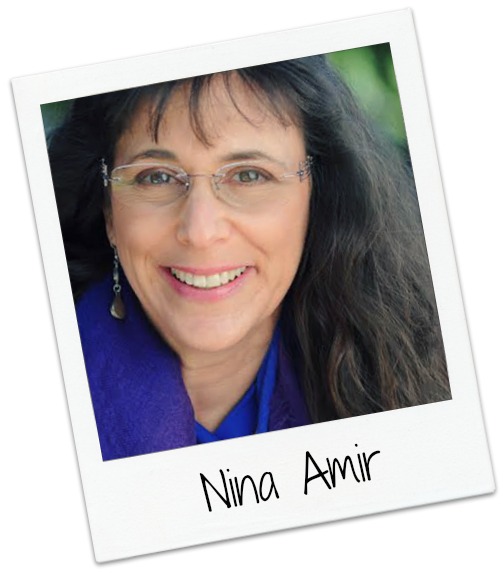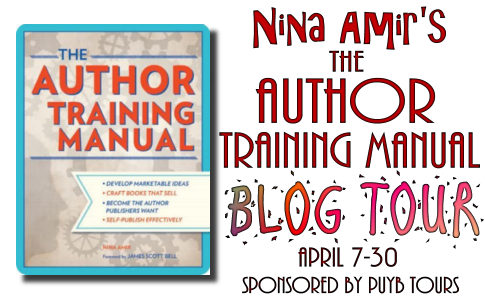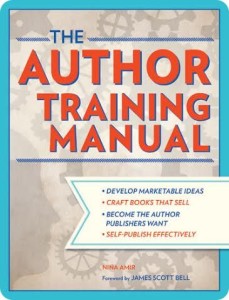Pump Up Your Book is proud to announce Nina Amir’s The Author Training Manual Virtual Book Tour April 7 – 30!
Title: The Author Training Manual
Author: Nina Amir
Publisher: Writer’s Digest Books
Pages: 256
Genre: Nonfiction
Format: Paperback/Kindle
Anyone can publish a book and become an “author,” but if you want to become a successful author with a profitable publishing career, you need a clear, step-by-step guide to help you develop book ideas that sell. In The Author Training Manual, expert editor and book coach Nina Amir reveals the exact process successful authors have used to create business plans and proposals for their books and teaches you how to view your ideas through the eyes of acquisition editors and literary agents.
Whether you write fiction or nonfiction, plan to traditionally publish or self-publish, The Author Training Manual provides you with the tools you need to achieve your goals and become the author publishers and readers want. Inside you’ll find concrete steps, evaluations, sample business plans, in-depth training activities, editor and agent commentaries, and much more – all designed to help you stand out, from the slush pile to the shelf.
Purchase your copy:
Discuss this book in our PUYB Virtual Book Club at Goodreads by clicking HERE
 Nina Amir, the Inspiration to Creation Coach and author of How to Blog a Book and The Author Training Manual,
transforms writers into authors. She inspires people from all walks of
life to create books that positively impact readers and to develop
careers as authors, achieve their goals, and fulfill their potential.
Nina is a sought-after nonfiction developmental editor, proposal
consultant, and author, book, blog-to-book, blog, and results coach.
Some of her clients have gone on to sell 300,000+ copies of their books
and to land deals with major publishing houses. She writes four blogs,
has self-published 12 books and is the founder of National Nonfiction
Writing Month, aka the Write Nonfiction in November Challenge.
Nina Amir, the Inspiration to Creation Coach and author of How to Blog a Book and The Author Training Manual,
transforms writers into authors. She inspires people from all walks of
life to create books that positively impact readers and to develop
careers as authors, achieve their goals, and fulfill their potential.
Nina is a sought-after nonfiction developmental editor, proposal
consultant, and author, book, blog-to-book, blog, and results coach.
Some of her clients have gone on to sell 300,000+ copies of their books
and to land deals with major publishing houses. She writes four blogs,
has self-published 12 books and is the founder of National Nonfiction
Writing Month, aka the Write Nonfiction in November Challenge.You can find all of Nina’s blogs by visiting her main website, www.ninaamir.com.
TWITTER | FACEBOOK
Author: Nina Amir
Publisher: Writer’s Digest Books
Pages: 256
Genre: Nonfiction
Format: Paperback/Kindle
Purchase at AMAZON
Anyone can publish a book and become an “author,” but if you want to
become a successful author with a profitable publishing career, you need a
clear, step-by-step guide to help you develop book ideas that sell. In The Author Training Manual, expert
editor and book coach Nina Amir reveals the exact process successful authors
have used to create business plans and proposals for their books and teaches
you how to view your ideas through the eyes of acquisition editors and literary
agents.
Whether you write
fiction or nonfiction, plan to traditionally publish or self-publish, The Author Training Manual provides you with the tools you need to
achieve your goals and become the author publishers and readers want. Inside
you’ll find concrete steps, evaluations, sample business plans, in-depth
training activities, editor and agent commentaries, and much more – all
designed to help you stand out, from the slush pile to the shelf.
Book Excerpt:
Millions of aspiring authors around the world dream of self-publishing
or traditionally publishing a successful book. If you’ve picked up this book,
you likely share that dream.
Today, almost any writer can change his or her status from aspiring to
published author.
More ways exist to self-publish a book than ever before, which means you
have many options should you choose to go that route. You’ll find it harder to
change your status from aspiring to published author if you want to be
traditionally published, but it’s not impossible. You just need to convince a
publishing company to produce your book for you by following the steps
presented in this book.
No matter which path to publication you choose, the most difficult task
before you involves creating a book that sells. According to Publishers Weekly,
the average book sells three thousand copies in its lifetime—not per year. The
publishing industry deems a book “success- ful” when it sells large numbers of
copies—usually many more than three thousand copies per year. Bestsellers, for
example, outsell other books in their categories.
Since you are reading this book, I’m going to assume from this point
forward that you want to produce a book that sells an above-average number of
copies per year or reaches bestseller status. That means you want to be a
successful author by publishing industry standards, so keep the average books
sales noted earlier mind as you work through this process.
Many aspiring authors think all they need to produce a successful book
is an outstanding idea, a sound story structure, and a well-crafted manuscript.
Indeed, these elements sometimes suffice, but more often creating a bestseller
or a book with above-average sales involves much more.
In particular, it takes a certain type of attitude. I call this an Author
Attitude.
The Cold, Hard Facts of the Publishing Industry
To develop Author Attitude, you must make yourself aware of the cold,
hard facts about the publishing industry. These facts are meant to help you
understand the difference between simply becoming an author and succeeding as
an author.
While the number of books published each year increases—Bowker projected
a staggering four thousand books per day were published in 2011—the number of
people and publishers who buy them decreases annually. That means the
marketplace has become increasingly competitive, making it harder to find
readers and publishers. Yet, out of a U.S. population of 317,132,631 people (as
of November 2013), 81 percent still want to write a book, according to The New
York Times.
Many writers produce manuscripts or books only to discover later that
their creations aren’t viable. After spending months or years writing and
honing their craft, these authors then suffer great heartbreak and
disappointment when they discover traditional publishers don’t want to publish
their manuscripts or readers don’t want to purchase their self-published books.
Maybe the writing isn’t up to par, or the book isn’t unique or helpful to
readers; the author might not have a “platform,” promotion plan, or expertise
in the subject area, among many other things. Platform is visibility,
authority, and engagement with your book’s target audience that gives you
influences in that market.
Today, many readers simply cannot find most books. Bowker reported that
in 2011, three million books were published in the United States. Marketing
expert and bestselling author Seth Godin predicted that fifteen million ISBN
numbers were purchased in 2012. If all of those ISBN numbers were used, it is
possible that at least as many books were published that same year. That’s a
lot of books for readers to sift through when deciding to make a purchase. It’s
easy for yours to get lost among them all.
Not only that, if your book is traditionally published, it stands less
than a one percent chance of being stocked in an actual brick-and-mortar
bookstore, according to Berrett- Koehler Publishers. Self-published books
almost never make it onto bookstore shelves. And if your book is not in
brick-and-mortar bookstores, you miss another chance for readers to discover
you or your book.
Even authors like Godin, with fourteen bestselling books, including
Permission Marketing and Tribes, normally get only one or two copies of their
books into each physical bookstore. In fact, Godin conducted a record-breaking
Kickstarter campaign for his newest book, The Icarus Deception,
primarily to prove to publishers that his books should be promoted inside
bookstores. Even his publisher needed proof that booksellers should carry large
quantities of his books and display them prominently. If a successful author
like Godin has trouble getting books into a bookstore, you can imagine how hard
this task proves for the average traditionally published author.
Once you get your book into either physical or online stores, you have
to find ways to get it noticed. You have to ensure its cover makes readers feel
they must not leave the store without it. The average nonfiction book sells 250
copies per year, reports Publishers Weekly—and nonfiction outsells fiction, so
we can assume the average novel sells fewer copies per year. Taking into
account the cost of editing and design, that’s hardly enough for any
traditional publisher or self-publisher to earn back the cost of producing and
promoting a printed book, let alone make much money. (Average yearly e-book
sales are about the same as print book sales, possibly just a tad higher.
According to novelist Mike Cooper, the average Amazon e- book author earns
under $300 per year.)
With these facts in mind, it’s no wonder that along the way some writers
discover they aren’t cut out to produce successful books—ones that do sell to
lots of readers and to publishers. They might discover this after they’ve
self-published or traditionally published their books or maybe while they are trying
to publish them (or even while exploring their options). Maybe they are
unwilling to learn the necessary tasks, they can’t or don’t want to hire
someone to help them do those tasks, or they simply don’t want to compete in
the industry or the marketplace. Maybe they have other commitments, like family
or a “real” job. So these writers may decide they feel comfortable writing
books that sell a below-average number of copies.
Others decide the path to publication is just too long and arduous. They
leave their dreams of becoming authors behind and choose different paths. They
give up.
Then there are the aspiring writers left wondering how—despite the above
facts, their situations, and the often harsh and competitive publishing
industry environment—they can change their status from aspiring to successful
published author. They are not put off by the obstacles in the facts presented
or by what life has thrown their way. Full of optimism, they cling to something
else they have heard: “Now is the best time in history to become an author.”
They are willing to do whatever it takes to produce a salable book and to
publish and promote it until it sells well. They are determined, persistent,
and perseverant. In fact, they have the essential characteristic of successful
authors: an Author Attitude.
I hope you have it, too.
If you aren’t sure whether you have this attitude, no worries. This
manual, and the training process it includes, will teach you how to develop an
Author Attitude.
Of course, some writers have this attitude naturally; most, I believe,
have worked at developing it. Jack Canfield and Mark Victor Hansen come to
mind. They received over 140 rejections prior to getting Chicken Soup for the
Soul accepted by Health Communications. The book has sold over 200 million
copies due to the authors’ commitment to promoting the book in every way
possible—including sending free copies to the sequestered jurors serving on the
nationally broadcast first O.J. Simpson murder trial. The jurors were then
pictured on national television carrying the books! The authors promoted the
book in five ways every single day after its release. Now that is Author
Attitude.
The Author Training Manual
Tour Page:








No comments:
Post a Comment